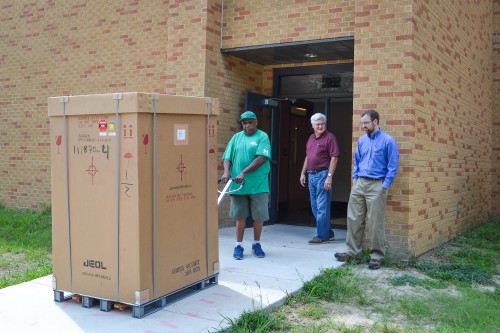 A new Scanning Electron Microscope, attained with funding through a Major Research Instrumentation grant award from the National Science Foundation, arrived on campus Tuesday in the renovated science wing of Caylor and Walters Hall.
A new Scanning Electron Microscope, attained with funding through a Major Research Instrumentation grant award from the National Science Foundation, arrived on campus Tuesday in the renovated science wing of Caylor and Walters Hall.Delta State students and faculty in the Division of Biological Sciences will soon be better equipped to engage in diverse scientific research investigations pertaining to biology, chemistry and environmental science thanks to the acquisition of a top-line microscope.
The Scanning Electron Microscope (SEM), attained with funding through a Major Research Instrumentation grant award from the National Science Foundation, arrived at its new home on campus Tuesday in the renovated science wing of Caylor and Walters Hall.
Dr. Nina Baghai-Riding, professor of biology and environmental science, worked closely with the Office of Institutional Grants to secure the grant award in 2013. She has led the effort to procure the $200,000 piece of scientific instrumentation.
Baghai-Riding worked closely with JEOL Ltd., a world leader in electron optical equipment and instrumentation for high-end scientific and industrial research and development. Division faculty were able to provide input to ensure the instrument would fit with their research interests and teaching requirements. Custom made, the SEM took more than five months to build.
The instrument will be used to enhance professors research relating to Jurassic, Cretaceous and Tertiary palynomorphs; analyzing leaf cuticle and the structural diversity in parasitic nematodes; finding cures relating to obesity; analyzing brownfields and other contaminated soils; investigating polymeric materials; and more.
It will be utilized regularly in the classroom for anatomy and physiology, parasitology, plant anatomy, environmental chemistry, cell biology, plant systematics and biology.
The SEM magnifies images up to 50,000 times normal size, allowing users to see numerous features unseen by the naked eye. The microscope also comes with an energy dispersive x-ray system attachment.
“More student and academic research will come as a result of this,” said Baghai-Riding. “It will be a great asset and will increase the employability of students in the sciences.”
In the past, science faculty at Mississippi State University have brought their SEM to Delta State to give students an opportunity to work on the advanced machine. Now, in addition to Delta State faculty and students, those from neighboring institutions — such as Mississippi Delta Community College, Coahoma Community College, Mississippi Valley State University and the USDA-Agricultural Research Station — will be able to utilize Delta State’s SEM.
Robin Boyles, director of the Office of Institutional Grants, hopes this equipment will attract additional funding for the sciences.
“This is an example of how grant dollars can be used to enhance teaching and learning, offering students classroom and laboratory experiences that might not otherwise be possible,” said Boyles.
The National Science Foundation is an independent federal agency that supports fundamental research and education across all fields of science and engineering. The NSF’s Major Research Instrumentation Program serves to increase access to shared scientific and engineering instruments for research and research training by assisting institutions and scientific organizations with the acquisition or development of a shared research instrument.

